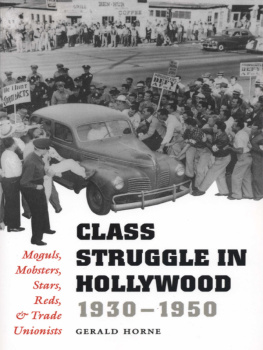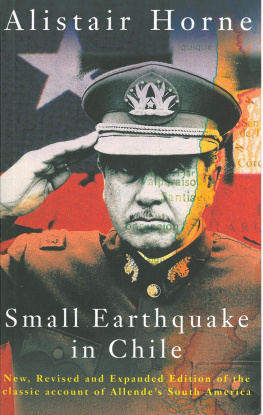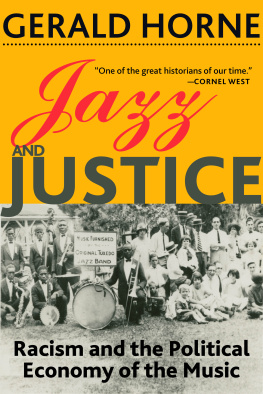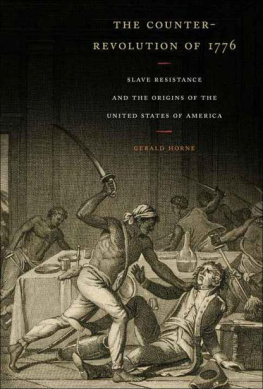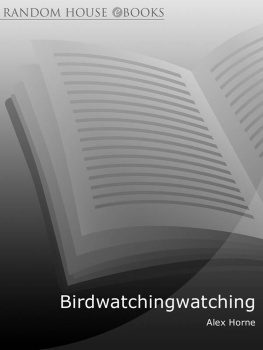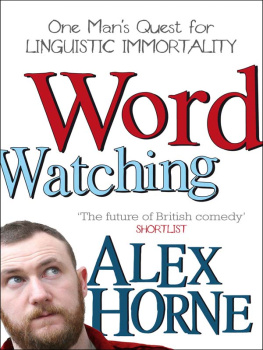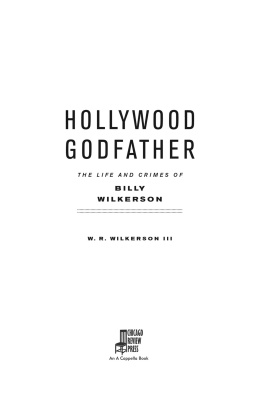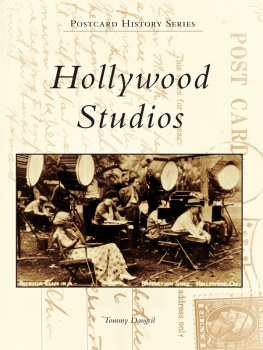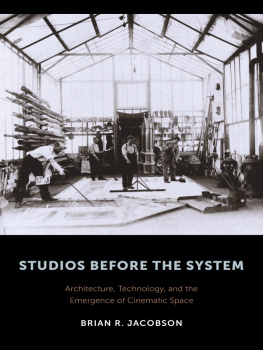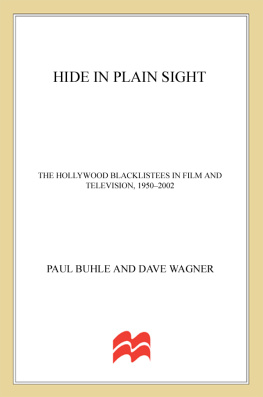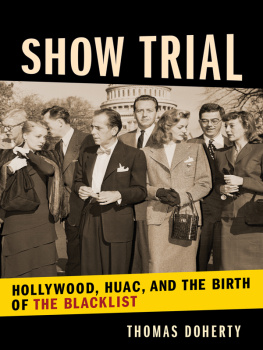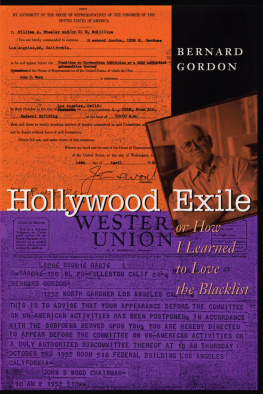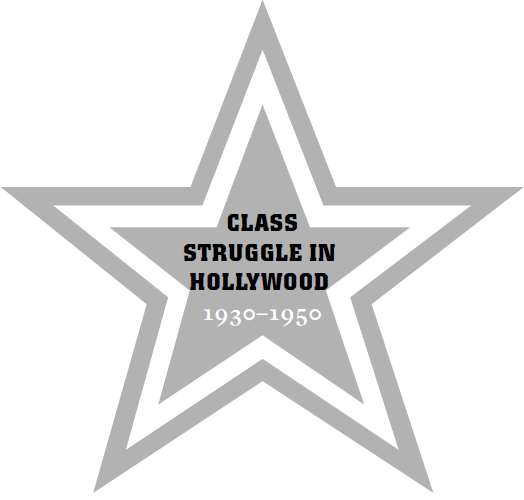GERALD HORNE
Moguls,
Mobsters,
Stars, Reds, &
Trade Unionists
University of Texas Press, Austin
Copyright 2001 by the University of Texas Press
All rights reserved
Printed in the United States of America
First edition, 2001
Requests for permission to reproduce material from this work should be sent to Permissions, University of Texas Press, P.O. Box 7819, Austin, TX 787137819.
utpress.utexas.edu/index.php/rp-form
LIBRARY OF CONGRESS CATALOGING-IN-PUBLICATION DATA
Library ebook ISBN: 978-0-292-79640-9
Individual ebook ISBN: 978-0-292-75013-5
DOI: 10.7560/731370
Horne, Gerald.
Class struggle in Hollywood, 19301950 : moguls, mobsters, stars, Reds, and trade unionists / by Gerald Horne.1st. ed.
p. cm.
Includes bibliographical references and index.
ISBN 0-292-73137-X (cl. : alk. paper)
ISBN 0-292-73138-8 (pbk. : alk. paper)
1. Motion picture industryEmployeesLabor unionsCaliforniaLos Angeles. I. Title.
PNI993.5.U65 H67 2001
331.8811791430979494dc21
00-025950
CONTENTS
This is a book about labor-management conflict in Hollywood. It concerns the attempt of the Conference of Studio Unions (CSU), a federation of craft unions led by painters and carpenters, to confront not only the major studios but also a competing union, International Alliance of Theatrical Stage Employees (IATSE) and its allies in organized crime. CSU went on strike in 1945 and was locked out in 1946. However, it fought its antagonists to a standstill in 1945. They were routed in 1946. The vanquishing of CSU erased progressive trade unionism for generations to come in one of this nations most significant industries.
CSUs enemies wielded one major chargethat the organization was led and dominated by members of the Communist Party. However, this allegation was wildly inaccurate. The CSUs leaderHerb Sorrellwas a painter and former boxer who appeared to have absorbed one too many punches to the skull. He was militant and fearless, but lacked tactical skills. He was publicly hostile to the Soviet Union and insensitively clumsy in addressing the needs and aspirations of Southern Californias African American population. Despite the fact that these actions were clearly not the hallmarks of Communist leadership in the first half of the twentieth century, the explosive cry of Communist effectively disrupted CSUs effort to win victories for its membership.
The unions downfall amounts to a controlled experiment that demonstrates vividly that accusations of communism were not just designed to drive out practicing Reds with ties to Moscow. This it did, most definitely, but these bombardments were also intended to damage militant non-Communist labor, which suffered fatal collateral damage. With the latter ousted, the path was primed for management to seize greater control of the production process and garner more profits by reducing once powerful mastifflike unions to the status of tiny, toothless terriers. The experience of Hollywood labor demonstrates that the Red Scare was in many ways an attack on militant unionism, conducted under the guise of an attack on communism.
The strife of the mid-1940s was also important for other reasons. At stake was nothing less than control over an industry that was essential in forging peoples consciousness. The titans of Hollywood had invested mightily in creating a star system that had captivated the imagination of millions worldwide who followed the doings of actorson and off the screen. Hollywood was surely a dream factory, and these iconic actors lived lives that were the stuff of dreams as they instructed and mesmerized. But how would the multitudes respond to the sight of their favorite stars on picket lines, embroiled in a class struggle? How would the masses react when the Oz-like curtain of illusion was ripped away, revealing that the issues in Hollywood were not that different from those in Detroit, Pittsburgh, and other labor-management battlefronts? Yet there was at least one significant difference: class struggle in Hollywood could grab attention and provide lessons in ways unmatched by other labor-capital conflicts.
Other factors help explain the ferocity of the onslaught on Hollywood labor. The screenwriters, which did include a complement of Communists, were indispensable in the production process. Though the moguls sought to show otherwise, making a decent movie without a competent screenplay based on a sound idea was tough. Even in the digital era of the twenty-first century, dispensing with writersunlike other guilds and unionswill be difficult. Moreover, screenwriters, who were genuinely interested in intellectual exchange and foreign film were countered by moguls who were desperately interested in constructing firm protectionist walls to keep international cinema out of the U.S. market. When the screenwriterswho actively fought against tariff walls that kept foreign films from U.S. audienceswere denuded of Communist influence, it became easier for the moguls to bar foreign films while conquering markets abroad. This protectionism provided a comfortable cushion of profitability that proved critical to the industry in the postWorld War II era in the face of a stiff challenge from television, independent film producers, and a successful antitrust lawsuit that disrupted the vertical integration of Hollywood. In fact, labor unrest in Hollywood erupted at an unpropitious moment for the moguls, confronted as they were by all manner of challengesnot least of which was anti-Semitism. Bulldozing CSU seemed all the more important in a context where nettle-some problems seemed to be proliferating and metastasizing.
As Communist and other leftist screenwriters like John Howard Lawson, Abraham Polonsky, Dalton Trumbo, Donald Ogden Stewart, Lester Cole, and Ring Lardner, Jr., were driven into purgatory, the ideological content of movies spiraled downward. Making films concerning racism, not to mention gender and class inequality, became more difficult and the road was paved for more beach blanket fluff. According to one analyst, weighty social problem films decreased from 20.9 percent of the studios output in 1947 to 9 percent in 1950 and 1951.
To be fair, CSU and the left had reason to be taken by surprise, for the anticommunist upsurge swept through the industry like a fast-moving, Southern California late-summer blaze. As late as the fall of 1946 Hollywoods chief spokesman, Eric Johnstonand the likeminded actor Ronald Reaganwere dismissing bedrock anticommunist notions. A shrewd businessman, Johnston was proud of his association with Josef Stalin during the war. By 1947 Johnston and Reagan had emerged as avatars of anticommunism and the blacklist. Apparently it was the intensity of the class struggle led by CSU that forced many in Hollywood to reconsider the utility of anticommunist tactics and to proceed fatefully toward an industry-wide blacklist.
CSU and the left had other problems. By the time the unions went on strike in 1945 the studios had squirreled away so many films that even if production were halted, fresh product would continue to reach the theaters. Moreover, the studios were the ones exhibiting class consciousness, standing shoulder-to-shoulder to confront a common foe, while the unions were busily knifing one another. The conflict in Hollywood illustrated an age-old lesson: class consciousness does exist in abundance in the United States; it is just painfully deficient among the working class.

